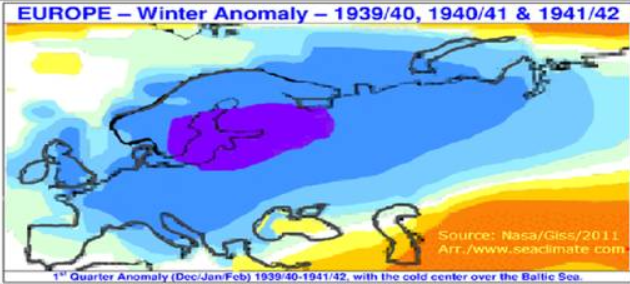
1. Introduction
Agriculture lies at the heart of civilization, and its success or failure depends critically on soil fertility and prevailing weather conditions. Throughout human history, variations in climate have directly influenced food availability, which in turn shaped demographic trends, social stability, and even the occurrence of wars and migrations. This article examines the interplay between weather, soil fertility, and peace by reviewing historical records, climatic drivers such as solar cycles and teleconnections, and the consequences of harvest variability on societies worldwide. Furthermore, it assesses projected regional fertility changes by 2100 under ongoing climate change and their likely implications for global security.
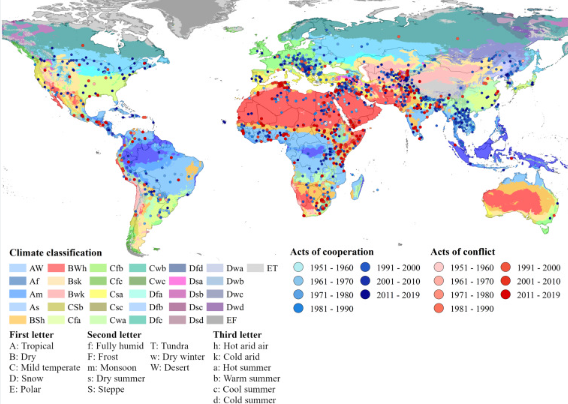
Water-related conflict and cooperation events worldwide. Source: https://www.sciencedirect.com/science/article/pii/S0048969723001705
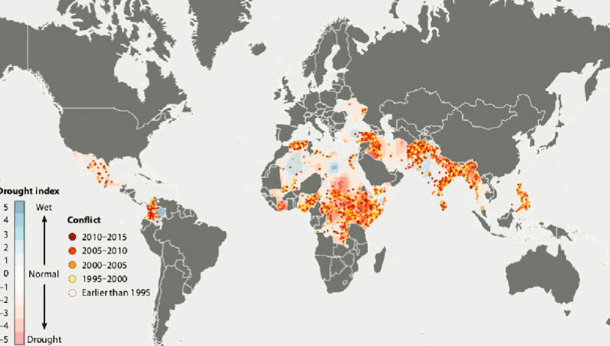
Drought-related conflict. Source: https://www.researchgate.net/figure/Global-map-showing-the-severity-of-drought-and-armed-conflict-events-Palmer-Drought_fig2_358988611
Table 1: Overview of Key Factors Linking Weather, Fertility, and Peace
| Factor | Description | Impact on Society | Example |
|---|---|---|---|
| Soil Fertility | Nutrient availability in soil | Crop yields, food security | Nile Delta fertility and civilization longevity |
| Weather Variability | Temperature, precipitation fluctuations | Harvest success/failure | Little Ice Age famines |
| Climatic Drivers | Solar cycles, ENSO, AO, NAO | Regional climate impacts | Maunder Minimum cooling |
| Societal Stability | Peace, migration, conflict | War outbreaks, social unrest | Syrian civil war and drought |
2. Historical Soil Fertility and Harvest Patterns (Pre-2000 AD)
Ancient Agricultural Centers and Soil Fertility
The earliest human societies flourished in regions with naturally fertile soils enriched by riverine processes. For instance, the Nile Delta’s annual floods deposited nutrient-rich sediments, renewing the soil and enabling consistent harvests for thousands of years. In Mesopotamia, however, irrigation was critical to compensate for low rainfall, but over centuries salinization reduced soil fertility, contributing to agricultural decline and societal stress.
Similarly, the Indus Valley civilization depended on fertile alluvial plains, which supported complex urban centers. Yet, archaeological evidence suggests periodic declines linked to shifts in monsoon patterns. In East Asia, the loess plateau and Yangtze basin offered fertile grounds for rice and millet cultivation but also faced soil erosion risks.
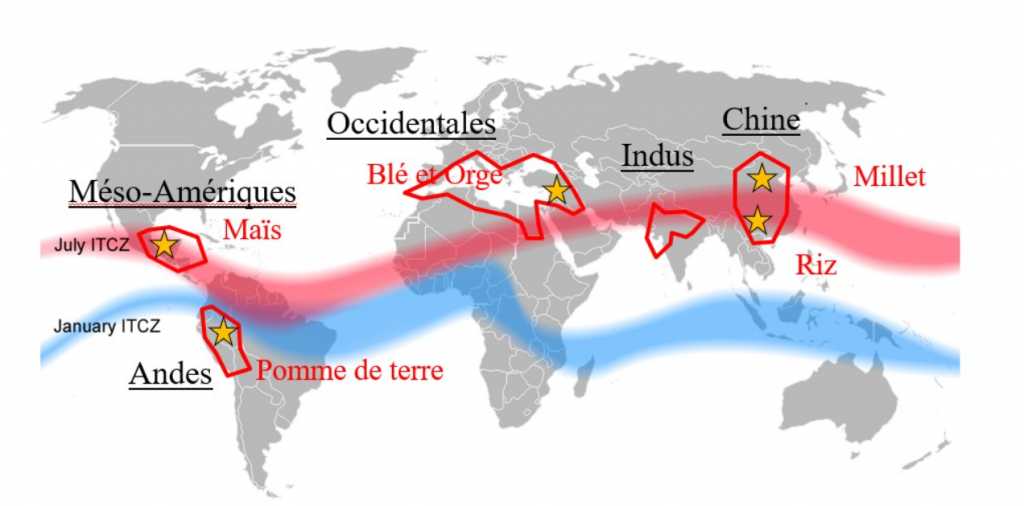
Distribution map of civilizations’ outbreaks and meteorological zones of heavy rainfall according to seasons (ITCZ). The extension areas of the first centers of ancient civilizations are surrounded by a red line. The stars represent the privileged areas of endemic agriculture (after V. Boqueho, ref.[1]). Background map: current location of the intertropical convergence zone (ITCZ) in January (blue-coloured zone) and July (pink-coloured zone) [Source : Mats Halldin, 2006, via Wikimedia commons [Public domain]]. Source: https://www.encyclopedie-environnement.org/en/climate/climate-change-and-ancient-civilizations-2/
Medieval and Pre-Industrial Agriculture
During the Medieval Warm Period (c. 900–1300 AD), Europe experienced generally mild and stable climates, encouraging agricultural expansion into marginal lands. Fertility was enhanced through practices such as fallowing and crop rotation, though soil depletion was a growing concern.
However, the onset of the Little Ice Age (c. 1300–1850) brought colder, wetter conditions, shortening growing seasons and increasing the frequency of harvest failures. This climatic deterioration is linked to catastrophic famines, such as the Great Famine of 1315–1317 in Europe, which led to widespread starvation and social upheaval.
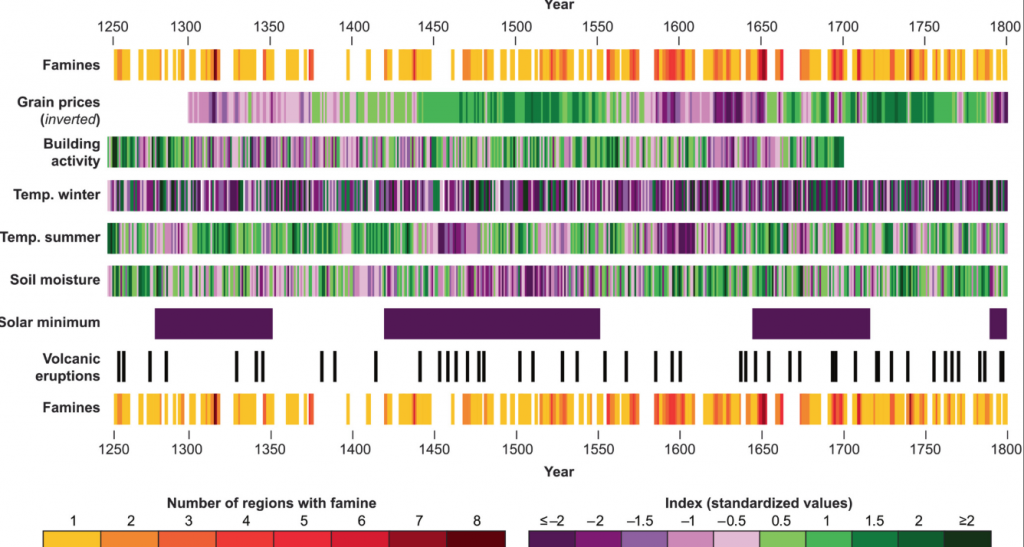
Source: https://wires.onlinelibrary.wiley.com/doi/10.1002/wcc.859
arted-in-early-1300s-and-europe-bore-the-brunt-of-its-ill-effects-for-500-years/
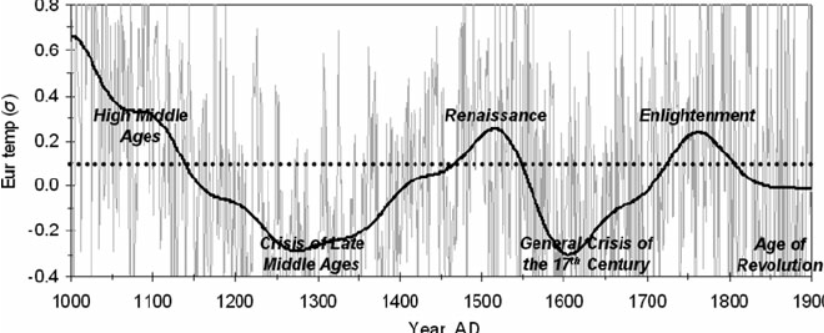
Soil Degradation and Recovery
Soil fertility was further impacted by deforestation, overgrazing, and improper land management. Many regions experienced erosion and nutrient depletion, which limited crop yields and heightened vulnerability to climatic stress. Only with the advent of industrial fertilizers and modern agricultural techniques in the 19th and 20th centuries did soil fertility and productivity begin to recover on a large scale.
3. Solar Cycles and Agricultural Productivity
Solar radiation is a fundamental driver of Earth’s climate and ecosystem productivity. The roughly 11-year solar cycle involves fluctuations in solar irradiance and sunspot numbers, influencing atmospheric and oceanic circulation patterns.
Solar Minima and Cooling Events
Extended periods of low solar activity, such as the Maunder Minimum (1645–1715), are associated with cooler temperatures, particularly in the Northern Hemisphere. Historical data link these periods to diminished harvests and increased famine risk in Europe and parts of Asia. For example, the harsh winters and shortened growing seasons during the Maunder Minimum coincided with multiple crop failures and social distress.
Solar Maxima and Agricultural Gains
Conversely, solar maxima correspond to warmer conditions with enhanced photosynthetic activity. These periods often see improved crop yields and expanded cultivation potential, although regional differences exist due to complex climate interactions.
Modulation of Weather Patterns
Solar cycles also modulate the stratosphere and troposphere temperature gradients, influencing phenomena such as the jet stream position and monsoon intensity. These shifts affect regional rainfall and temperature patterns critical to agriculture.
Table 2: Solar Minima and Corresponding Climate Impacts on Agriculture
| Solar Minimum | Period | Temperature Anomaly (°C) | Documented Agricultural Impact | Example Region |
|---|---|---|---|---|
| Maunder Minimum | 1645–1715 | -0.5 to -1.0 | Crop failures, famines | Europe, China |
| Dalton Minimum | 1790–1830 | -0.3 to -0.6 | Shortened growing seasons | Europe, North America |
| Modern Minimum | 1900–1915 | Minor cooling | Localized droughts and cold snaps | Various |
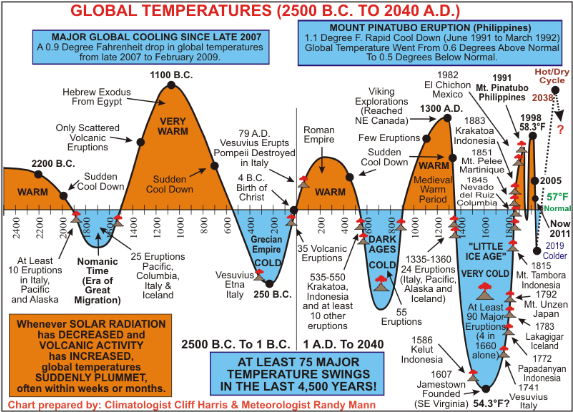
Source: https://edsimoneit.blog/2018/10/30/the-little-ice-age-st
4. Climate Teleconnections and Their Agricultural Effects
El Niño Southern Oscillation (ENSO)
ENSO represents a coupled ocean-atmosphere phenomenon with two main phases: El Niño (warm phase) and La Niña (cool phase). These phases significantly alter global weather:
- El Niño: Causes drought in Southeast Asia, Australia, and parts of Africa; increased rainfall in western South America. This variability leads to crop failures in drought-stricken zones and flooding in others.
- La Niña: Tends to produce opposite effects, with wetter conditions in Australia and drought in South America’s west coast.
ENSO events have historically been associated with agricultural disruptions, population displacement, and social unrest, particularly in regions highly dependent on stable monsoon rains or consistent growing seasons.
Table 3: ENSO Phase Impacts on Agriculture by Region
| ENSO Phase | Region | Typical Weather Impact | Agricultural Consequence |
|---|---|---|---|
| El Niño | Southeast Asia, Australia | Drought, reduced rainfall | Crop failures, food shortages |
| El Niño | Western South America | Heavy rainfall, flooding | Soil erosion, crop damage |
| La Niña | Southeast Asia, Australia | Increased rainfall | Potential crop growth increase |
| La Niña | Western South America | Drought | Yield reductions |
Arctic Oscillation (AO) and North Atlantic Oscillation (NAO)
AO and NAO influence winter weather across Europe and North America:
- Positive NAO: Brings mild, wet winters in Europe, favoring soil moisture replenishment and improving agricultural outcomes.
- Negative NAO: Causes colder, drier winters or excessive snow, damaging crops or shortening the growing season.
Variability in AO/NAO also impacts North African and Middle Eastern climates, regions where water scarcity critically limits fertility.

AO- / NAO- winters during WW2. Source: https://www.seaclimate.com/b/b.html

Source: https://www.seaclimate.com/b/b.html
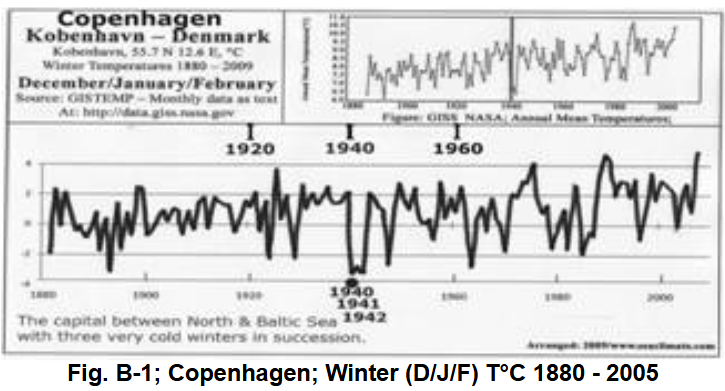
Source: https://www.seaclimate.com/b/b.html
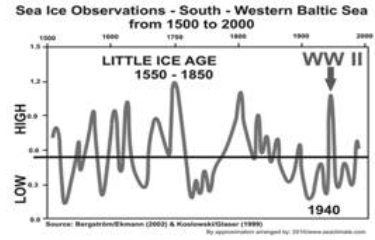
Source: https://www.seaclimate.com/b/b.html
Other Teleconnections
The Indian Ocean Dipole (IOD) and Pacific Decadal Oscillation (PDO) modulate monsoon intensity and drought frequency, affecting soil moisture and crop yields across South Asia and East Africa.
5. Climate Variability, Fertility, and Societal Stability
Historic Famines, Plagues, and Social Unrest
Agricultural shortfalls driven by climatic variability have repeatedly precipitated famines and outbreaks of disease. The Great Famine of 1315-1317, preceded by a series of cold, wet summers, killed millions in Europe and undermined social order. The subsequent Black Death further destabilized societies.
In China, drought and harvest failures linked to volcanic activity and solar minima contributed to rebellions and regime changes during the Ming Dynasty. Similarly, the Little Ice Age exacerbated hardships globally.
Table 4: Major Famines Linked to Climate Events (1300–1900)
| Famine | Period | Climatic Cause | Impact on Society | Region |
|---|---|---|---|---|
| Great Famine | 1315–1317 | Little Ice Age wet/cold | Widespread starvation | Europe |
| Ming Dynasty Famine | 1600s | Volcanic cooling | Rebellions, regime instability | China |
| Irish Potato Famine | 1845–1852 | Cold, wet conditions | Mass starvation, emigration | Ireland |
Wars and Migrations
Food scarcity often triggers conflict. For example, crop failures in France in the late 18th century heightened tensions that contributed to the French Revolution. More recently, droughts and poor harvests in Syria from 2006-2010 have been implicated as a factor in civil unrest and migration.
Population displacement due to failed harvests has been a recurring pattern throughout history, stressing neighboring regions and occasionally igniting conflicts.
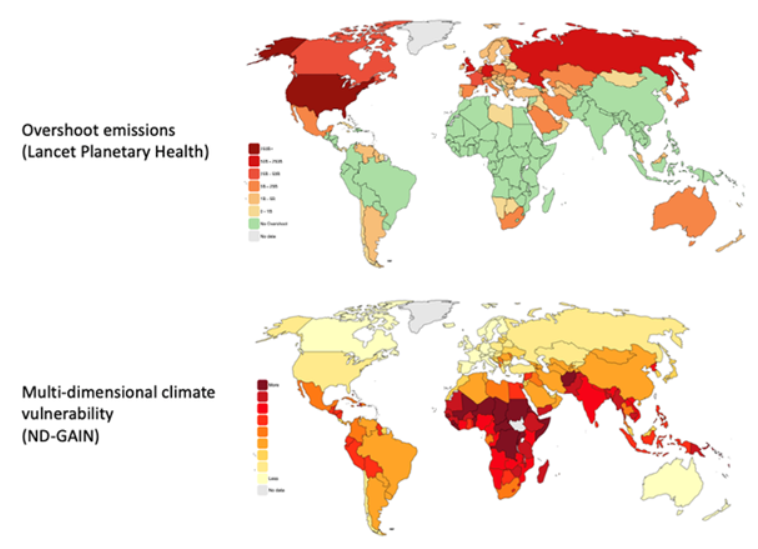
Source: https://www.cadtm.org/Climate-change-and-wars
6. Regional Fertility Trends: Past to Present
Europe
Europe’s fertile loess and alluvial soils supported dense populations for centuries. The Industrial Revolution introduced synthetic fertilizers, reversing centuries of soil degradation. However, climate variability and extreme weather events remain threats to yield stability.
Asia
Monsoon-dependent regions in South and Southeast Asia face significant risk from shifting rainfall patterns. While fertile river valleys like the Ganges-Brahmaputra and Mekong sustain billions, variability and land-use changes threaten soil health.
Africa
Desertification, land degradation, and inconsistent rainfall challenge African agriculture, particularly in the Sahel and Horn of Africa. These stresses reduce soil fertility and exacerbate food insecurity.
Americas
In the Americas, fertile prairies and river basins underpin major agricultural production. However, droughts, floods, and deforestation threaten these systems.
Oceania
Soil fertility varies widely, with some Pacific islands reliant on fragile soils sensitive to climatic fluctuations driven by ENSO.
Table 5: Expected Changes in Soil Fertility and Agricultural Potential by Region
| Region | Projected Change | Primary Causes | Potential Societal Impact |
|---|---|---|---|
| Northern Europe & Canada | Increase (+15-30%) | Warming, longer growing season | Population growth, migration |
| Mediterranean Basin | Decrease (-20-40%) | Drought, soil erosion | Food insecurity, conflicts |
| Sub-Saharan Africa | Decrease (-30-50%) | Desertification, rainfall decline | Hunger, migration |
| Central Asia | Mixed | Variable precipitation | Instability potential |

World Map Showing Human Induced Soil Degradation (International Soil Reference and Information Centre, 2017). Source: https://www.researchgate.net/figure/World-Map-Showing-Human-Induced-Soil-Degradation-International-Soil-Reference-and_fig1_330653251
7. Projected Fertility Trends and Climate Impacts by 2100
Northern Expansion of Fertile Zones
Warming temperatures may lengthen growing seasons in high-latitude regions (Canada, Russia), potentially enhancing soil fertility as permafrost thaws and organic matter becomes available.
Desertification and Soil Degradation
Conversely, increased aridity and land misuse threaten fertile soils in subtropical and tropical zones, including southern Europe, the Middle East, North Africa, and parts of Australia.
Extreme Weather Events
More frequent and intense droughts, floods, and storms accelerate soil erosion, reduce organic matter, and limit nutrient availability.
Technological and Management Solutions
Advances in soil conservation, irrigation, crop genetics, and agroecology offer hope for maintaining or improving fertility despite climatic challenges.
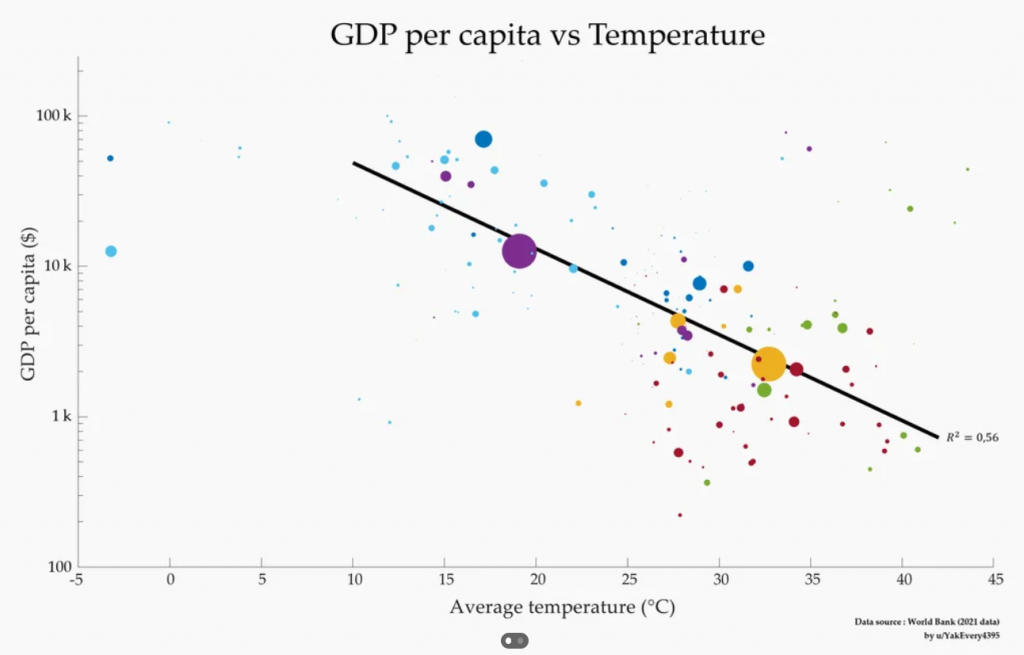
8. Consequences for Global Peace and Security
Declining agricultural productivity heightens food insecurity, which can fuel migration, social unrest, and conflict. Regions experiencing fertility loss may face intensified competition over arable land and water resources.
Conversely, areas gaining agricultural potential could experience demographic growth and increased geopolitical importance, sometimes heightening tensions.
Climate-induced fertility shifts demand integrated peace and security approaches that address food systems and environmental resilience.
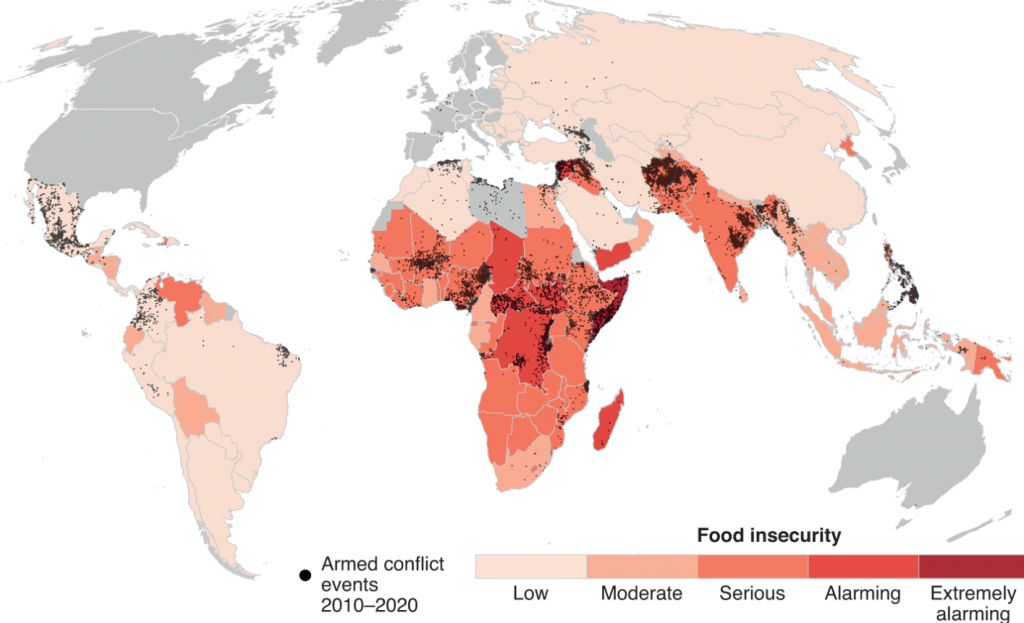
Source: https://www.nature.com/articles/s43016-021-00435-1
9. Strategies for Sustainable Soil and Agricultural Management
Sustainable agriculture must prioritize soil conservation through:
- Agroforestry and intercropping to maintain soil structure and organic content.
- Crop rotation and cover cropping to prevent nutrient depletion.
- Improved water management, including efficient irrigation and rainwater harvesting.
- Restoration of degraded lands with organic amendments and reduced tillage.
- Policy frameworks encouraging sustainable land use and climate adaptation.
International cooperation and investment in agricultural research and development will be vital.
Table 6: Soil Conservation Practices and Their Benefits
| Practice | Description | Benefits | Regions Where Applied |
|---|---|---|---|
| Agroforestry | Integrating trees with crops | Improved soil structure, moisture retention | Africa, Latin America |
| Crop Rotation | Alternating crop species | Nutrient cycling, pest control | Europe, Asia |
| Reduced Tillage | Minimizing soil disturbance | Soil organic matter preservation | North America, Australia |
| Organic Amendments | Use of compost/manure | Nutrient replenishment | Global |
10. Conclusion
Weather, fertility, and peace are deeply interconnected. Historical evidence reveals how climatic fluctuations have influenced soil health, harvest yields, and the rise and fall of civilizations. As we face unprecedented climate change, understanding and anticipating these links is critical to building resilient agricultural systems and peaceful societies. Strategic management of soil resources, informed by climatic knowledge, will be a cornerstone of global sustainability through the 21st century.


























